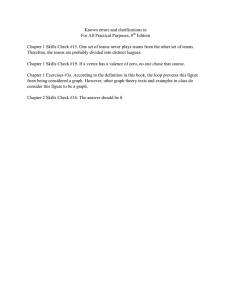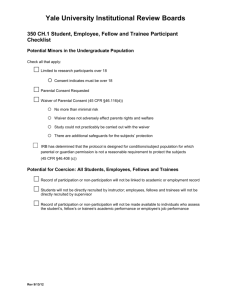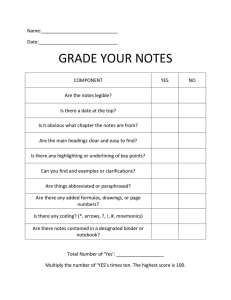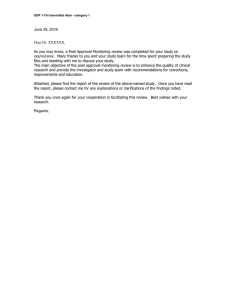IRB EXPEDITED REVIEW TEMPLATE
advertisement
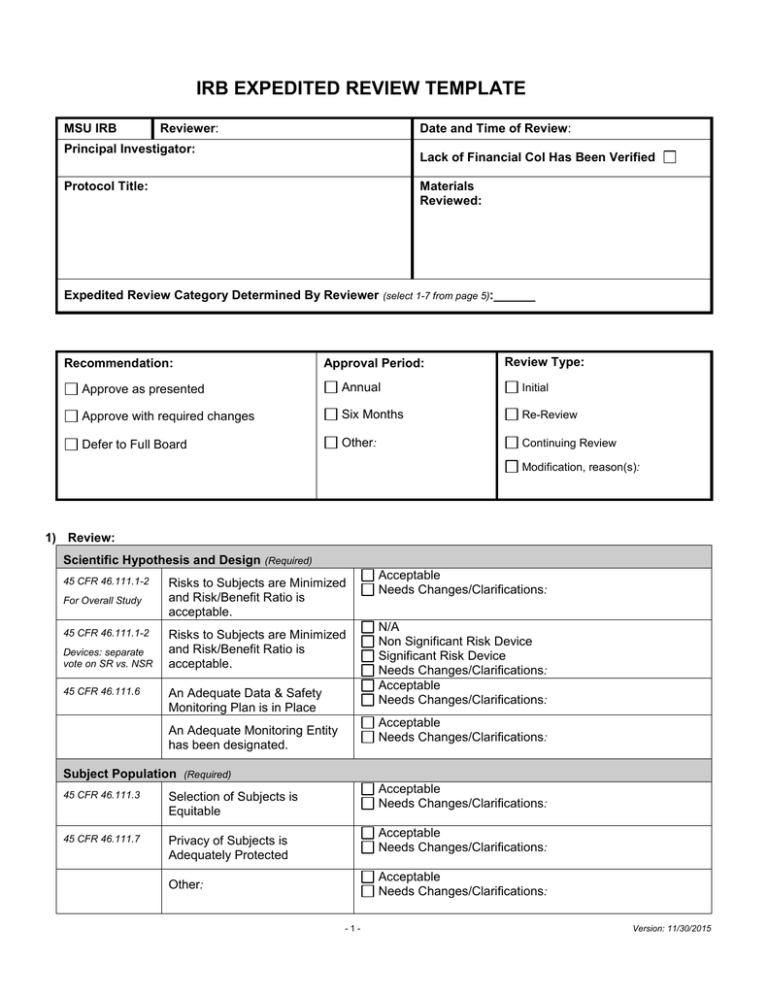
IRB EXPEDITED REVIEW TEMPLATE MSU IRB Reviewer: Date and Time of Review: Principal Investigator: Lack of Financial CoI Has Been Verified Protocol Title: Materials Reviewed: Expedited Review Category Determined By Reviewer (select 1-7 from page 5):______ Recommendation: Approval Period: Review Type: Approve as presented Annual Initial Approve with required changes Six Months Re-Review Defer to Full Board Other: Continuing Review Modification, reason(s): 1) Review: Scientific Hypothesis and Design (Required) 45 CFR 46.111.1-2 For Overall Study 45 CFR 46.111.1-2 Devices: separate vote on SR vs. NSR 45 CFR 46.111.6 Risks to Subjects are Minimized and Risk/Benefit Ratio is acceptable. Risks to Subjects are Minimized and Risk/Benefit Ratio is acceptable. An Adequate Data & Safety Monitoring Plan is in Place Acceptable Needs Changes/Clarifications: N/A Non Significant Risk Device Significant Risk Device Needs Changes/Clarifications: Acceptable Needs Changes/Clarifications: Acceptable Needs Changes/Clarifications: An Adequate Monitoring Entity has been designated. Subject Population (Required) 45 CFR 46.111.3 Selection of Subjects is Equitable 45 CFR 46.111.7 Privacy of Subjects is Adequately Protected Acceptable Needs Changes/Clarifications: Acceptable Needs Changes/Clarifications: Acceptable Needs Changes/Clarifications: Other: -1- Version: 11/30/2015 Informed Consent (Required) 45 CFR 46.111.4-5 Informed Consent will be Sought/ Documented 45 CFR 46.116(a)(b) Elements of Informed Consent are Included in Consent Form Acceptable Waiver/Alteration of Consent/Documentation is Requested Reconsent? If so, when/how: Needs Clarifications: N/A Acceptable Needs Changes/Clarifications: (complete checklist below) Waiver/Alteration of Consent: All of the following criteria must be met to satisfy a Waiver 45 CFR 46.116(d) of Consent: The research involves no more than minimal risk to subjects The Waiver or Alteration will not adversely affect the rights and welfare of subjects The research could not practicably be carried out without the waiver or alteration Whenever appropriate, subjects will be provided with additional pertinent information after participation N/A Alteration Acceptable: Complete Waiver Acceptable: Needs Changes/Clarifications: Waiver of Documentation of Consent: 45 CFR 46.117(c) One of the following must be met to satisfy Waiver of Documentation: That the only record linking the subject and the research would be the consent document and the principal risk would be potential harm resulting from a breach of confidentiality. Each subject will be asked whether the subject wants documentation linking the subject with the research, and the subject’s wishes will govern. OR… That the research presents no more than minimal risk of harm to subjects and involves no procedures for which written consent is normally required outside of the research context. N/A Acceptable: Needs Changes/Clarifications: Waiver/Alteration of Authorization: 45 CFR 160 & 164 All of the following must be met to satisfy Waiver of Authorization: 1. The use and disclosure of the PHI involves no more than minimal risk to the privacy of individuals based on, at least, the presence of the following elements: N/A Partial Waiver Acceptable, Terms: Complete Waiver Acceptable: Needs Changes/Clarifications: An adequate plan to protect health information identifiers from improper use and disclosure. An adequate plan to destroy identifiers at the earliest opportunity consistent with conduct of the research (absent a health or research justification for retaining them or a legal requirement to do so). Adequate written assurances that the PHI will not be reused or disclosed to (shared with) any other person or entity, except as required by law, for authorized oversight of the research study, or for other research for which the use or disclosure of the PHI would be permitted under the Privacy Rule. 2. 3. The research could not practicably be conducted without the waiver or alteration. The research could not practicably be conducted without access to and use of the PHI. -2- Version: 11/30/2015 Additional Issues & Resolutions (not addressed above): Issue Resolution (Include protocol-specific basis for each finding, if applicable) Vulnerable Population(s) Determinations: Vulnerable Populations: None Pregnant Women, Fetuses Children Prisoners Placenta, Dead Fetus/Fetal Material Neonates Other: Description of Vulnerable Population Determinations Determination (cite each specific regulation separately) Justification (Must include study-specific basis for decision) Issues Documented in Reviewer(s) Notes: Issue Resolution (Include protocol-specific basis if applicable) -3- Version: 11/30/2015 ELEMENTS OF INFORMED CONSENT CHECKLIST 45 CFR 46.116(a) 116(a)(1) 116(a)(2) Basic Elements of Informed Consent are Included in Consent Form Statement of Purpose, Duration, Procedures Description of Foreseeable Risks/Discomforts 116(a)(3) Description of Benefits 116(a)(4) Disclosure of Appropriate Alternatives 116(a)(5) 116(a)(6) 116(a)(7) 116(a)(8) 45 CFR 46.116(b) 116(b)(1) 116(b)(2) Description of Confidentiality Practices Description of Costs/ Compensation Description of Liability and Whom to Contact with Questions or if Injury Occurs Statement that Participation is Voluntary Acceptable Needs Changes/Clarifications: Acceptable Needs Changes/Clarifications: Acceptable Needs Changes/Clarifications: Acceptable Needs Changes/Clarifications: Acceptable Needs Changes/Clarifications: Acceptable Needs Changes/Clarifications: Acceptable Needs Changes/Clarifications: Acceptable Needs Changes/Clarifications: Additional Elements of Informed Consent, when Applicable, must be Included in Consent Form Statement that Study may Involve Unforeseeable Risks Circumstances Under Which Participation may be Terminated 116(b)(3) Additional Costs to Subject Resulting from Participation 116(b)(4) Consequences of Subject Withdrawal 116(b)(5) Statement that Significant New Findings that may Affect Willingness to Participate will be Provided 116(b)(6) Approximate # of Subjects in Study N/A Acceptable Needs Changes/Clarifications: N/A Acceptable Needs Changes/Clarifications: N/A Acceptable Needs Changes/Clarifications: N/A Acceptable Needs Changes/Clarifications: N/A Acceptable Needs Changes/Clarifications: N/A Acceptable Needs Changes/Clarifications: Other: -4- Version: 11/30/2015 Categories of Research That May Be Reviewed by the Institutional Review Board (IRB) through an Expedited Review 1. Clinical studies of drugs and medical devices only when condition (a) or (b) is met. a. Research on drugs for which an investigational new drug application (21 CFR Part 312) is not required. (Note: Research on marketed drugs that significantly increases the risks or decreases the acceptability of the risks associated with the use of the product is not eligible for expedited review.) b. Research on medical devices for which (i) an investigational device exemption application (21 CFR Part 812) is not required; or (ii) the medical device is cleared/approved for marketing and the medical device is being used in accordance with its cleared/approved labeling. 2. Collection of blood samples by finger stick, heel stick, ear stick, or venipuncture as follows: a. from healthy, non-pregnant adults who weigh at least 110 pounds. For these subjects, the amounts drawn may not exceed 550 ml in an 8 week period and collection may not occur more frequently than 2 times per week; or b. from other adults and children2, considering the age, weight, and health of the subjects, the collection procedure, the amount of blood to be collected, and the frequency with which it will be collected. For these subjects, the amount drawn may not exceed the lesser of 50 ml or 3 ml per kg in an 8 week period and collection may not occur more frequently than 2 times per week. 3. Prospective collection of biological specimens for research purposes by noninvasive means. Examples: (a) hair and nail clippings in a non-disfiguring manner; (b) deciduous teeth at time of exfoliation or if routine patient care indicates a need for extraction; (c) permanent teeth if routine patient care indicates a need for extraction; (d) excreta and external secretions (including sweat); (e) uncannulated saliva collected either in an unstimulated fashion or stimulated by chewing gumbase or wax or by applying a dilute citric solution to the tongue; (f) placenta removed at delivery; (g) amniotic fluid obtained at the time of rupture of the membrane prior to or during labor; (h) supra- and sub-gingival dental plaque and calculus, provided the collection procedure is not more invasive than routine prophylactic scaling of the teeth and the process is accomplished in accordance with accepted prophylactic techniques; (i) mucosal and skin cells collected by buccal scraping or swab, skin swab, or mouth washings; (j) sputum collected after saline mist nebulization. 4. Collection of data through noninvasive procedures (not involving general anesthesia or sedation) routinely employed in clinical practice, excluding procedures involving x-rays or microwaves. Where medical devices are employed, they must be cleared/approved for marketing. (Studies intended to evaluate the safety and effectiveness of the medical device are not generally eligible for expedited review, including studies of cleared medical devices for new indications.) Examples: (a) physical sensors that are applied either to the surface of the body or at a distance and do not involve input of significant amounts of energy into the subject or an invasion of the subject’s privacy; (b) weighing or testing sensory acuity; (c) magnetic resonance imaging; (d) electrocardiography, electroencephalography, thermography, detection of naturally occurring radioactivity, electroretinography, ultrasound, diagnostic infrared imaging, doppler blood flow, and echocardiography; (e) moderate exercise, muscular strength testing, body composition assessment, and flexibility testing where appropriate given the age, weight, and health of the individual. 5. Research involving materials (data, documents, records, or specimens) that have been collected or will be collected solely for non-research purposes (such as medical treatment or diagnosis). (NOTE: Some research in this category may be exempt from the HHS regulations for the protection of human subjects. 45 CFR 46.101(b)(4). This listing refers only to research that is not exempt.) 6. Collection of data from voice, video, digital, or image recordings made for research purposes. 7. Research on individual or group characteristics or behavior (including, but not limited to, research on perception, cognition, motivation, identity, language, communication, cultural beliefs or practices, and social behavior) or research employing survey, interview, oral history, focus group, program evaluation, human factors evaluation, or quality assurance methodologies. (NOTE: Some research in this category may be exempt from the HHS regulations for the protection of human subjects. 45 CFR 46.101(b)(2) and (b)(3). This listing refers only to research that is not exempt.) -5- Version: 11/30/2015
